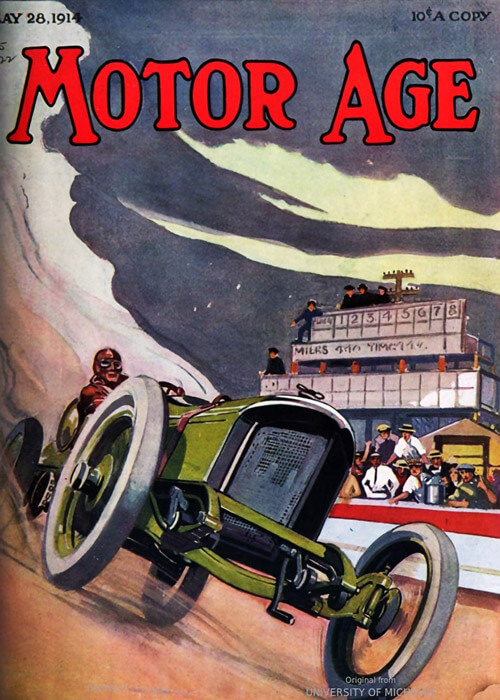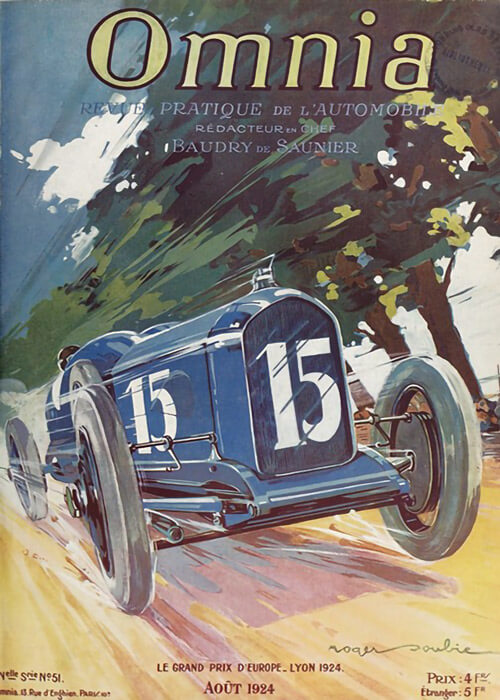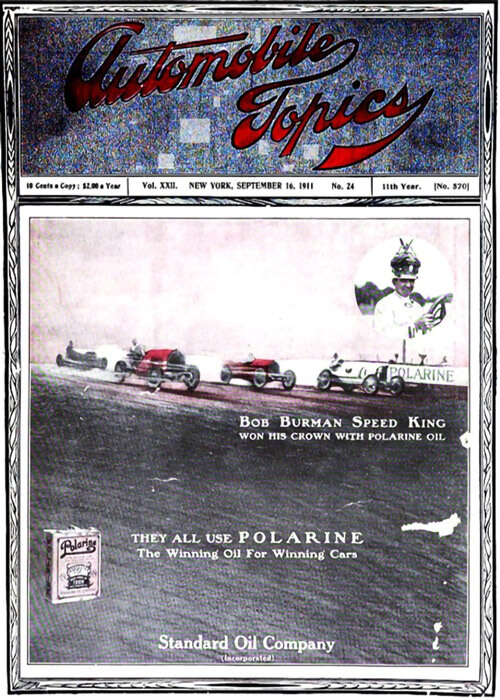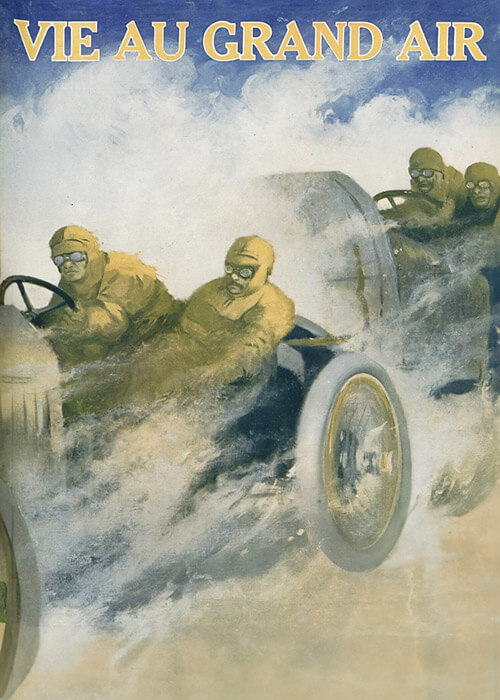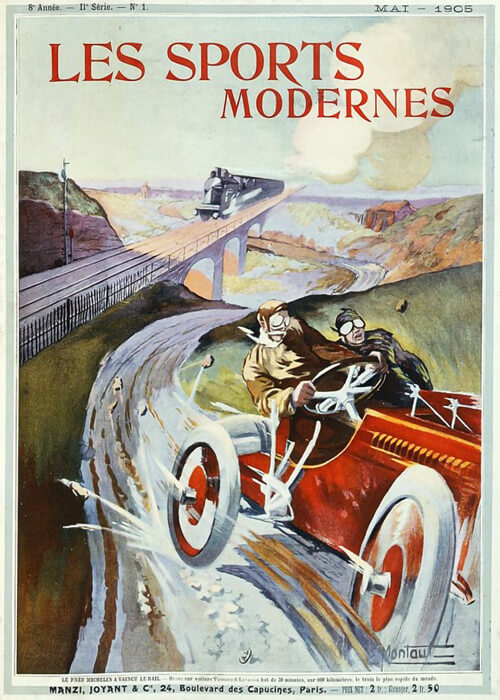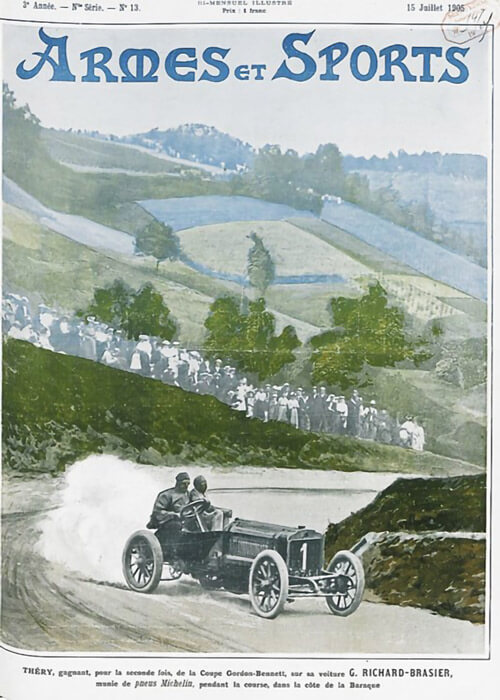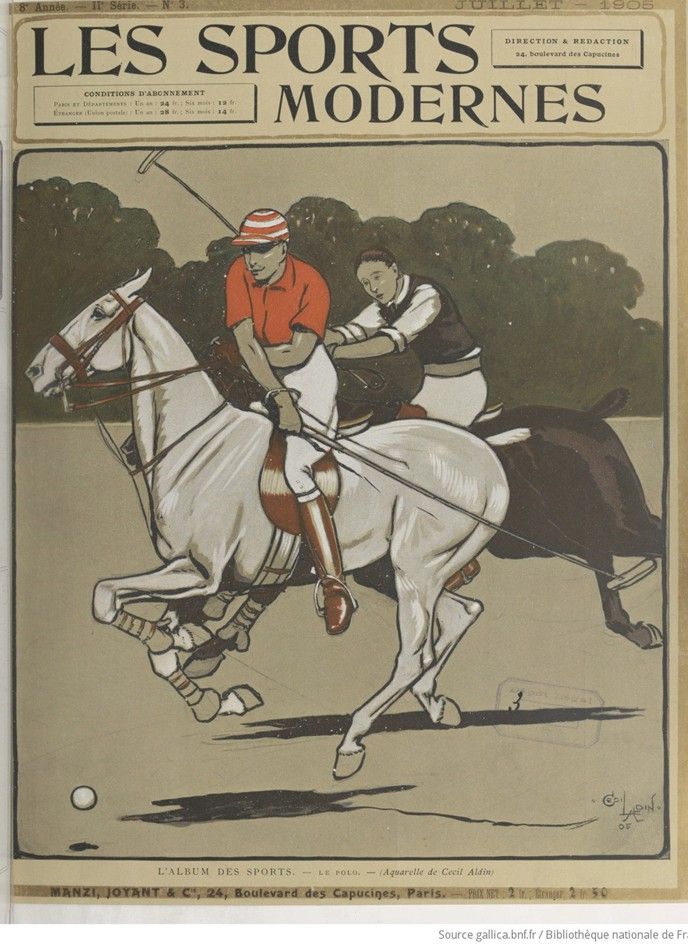
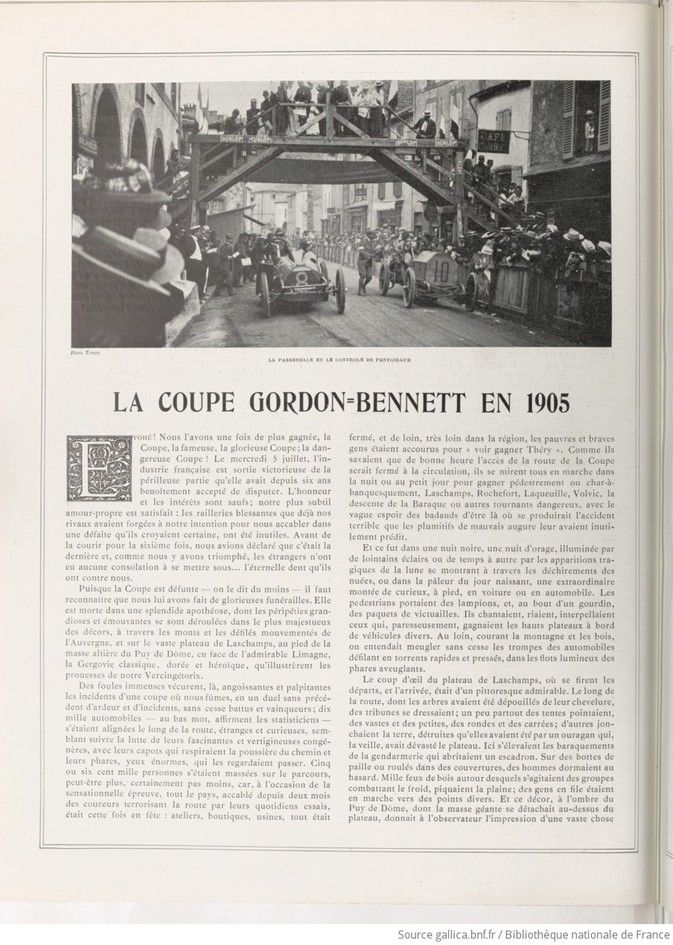
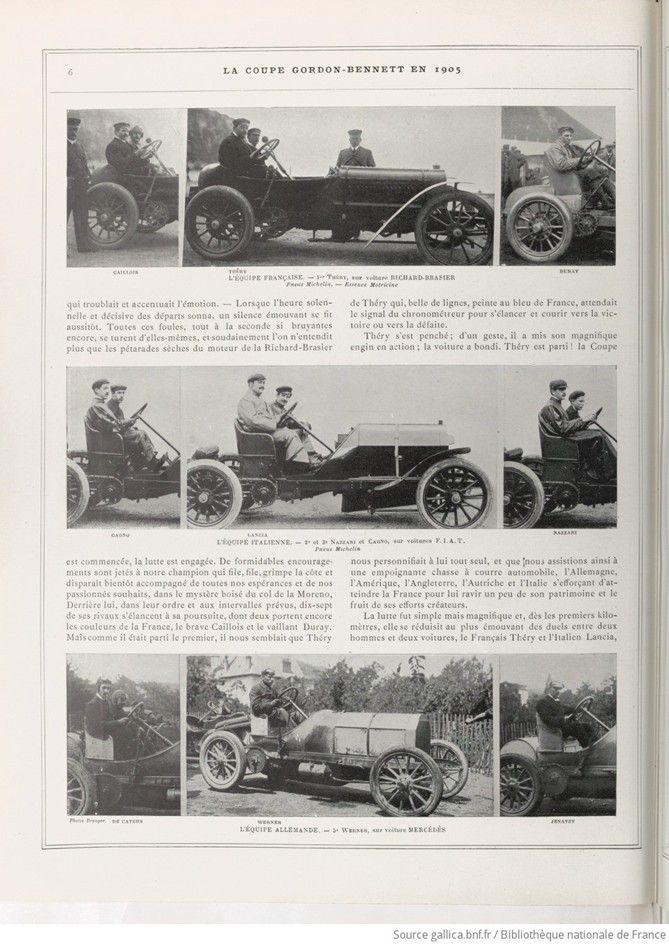
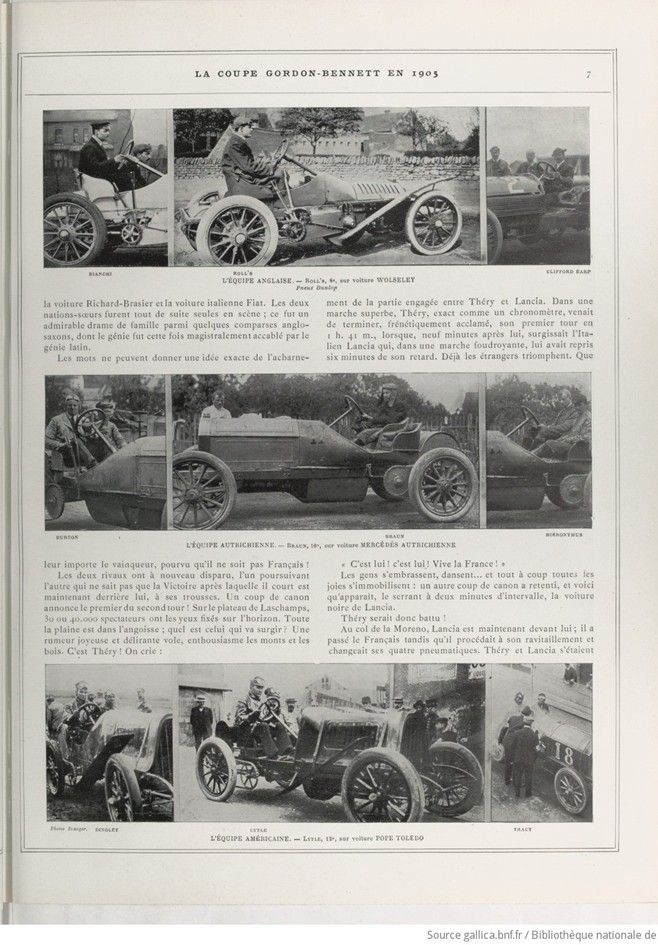
Avec l’authorisation du Bibliothèque nationale de France – gallica.bnf.fr https://www.bnf.fr/fr
Text et photos compilé per motorracinghistory.com
Les Sports Modernes, Vol. 8, 2e Série, No. 3, Juillet 1905
LA COUPE GORDON=BENNETT EN 1905
ÉVOHÉ ! Nous l’avons une fois de plus gagnée, la Coupe, la fameuse, la glorieuse Coupe ; la dangereuse Coupe Le mercredi 5 juillet, l’industrie française est sortie victorieuse de la périlleuse partie qu’elle avait depuis six ans benoîtement accepté de disputer. L’honneur et les intérêts sont saufs ; notre plus subtil amour-propre est satisfait : les railleries blessantes que déjà nos rivaux avaient forgées à notre intention pour nous accabler dans une défaite qu’ils croyaient certaine, ont été inutiles. Avant de la courir pour la sixième fois, nous avions déclaré que c’était la dernière et, comme nous y avons triomphé, les étrangers n’ont eu aucune consolation à se mettre sous… l’éternelle dent qu’ils ont contre nous.
Puisque la Coupe est défunte — on le dit du moins — il faut reconnaître que nous lui avons fait de glorieuses funérailles. Elle est morte dans une splendide apothéose, dont les péripéties grandioses et émouvantes se sont déroulées dans le plus majestueux des décors, à travers les monts et les défilés mouvementés de l’Auvergne, et sur le vaste plateau de Laschamps, au pied de la masse altière du Puy de Dôme, en face de l’admirable Limagne, la Gergovie classique, dorée et héroïque, qu’illustrèrent les prouesses de notre Vercingétorix.
Des foules immenses vécurent, là, angoissantes et palpitantes les incidents d’une coupe où nous fûmes, en un duel sans précédent d’ardeur et d’incidents, sans cesse battus et vainqueurs; dix mille automobiles — au bas mot, affirment les statisticiens s’étaient alignées le long de la route, étranges et curieuses, semblant suivre la lutte de leurs fascinantes et vertigineuses congénères, avec leurs capots qui respiraient la poussière du chemin et leurs phares, yeux énormes, qui les regardaient passer. Cinq ou six cent mille personnes s’étaient massées sur le parcours, peut-être plus, certainement pas moins, car, à l’occasion de la sensationnelle épreuve, tout le pays, accablé depuis deux mois des coureurs terrorisant la route par leurs quotidiens essais, était cette fois en fête : ateliers, boutiques, usines, tout était fermé, et de loin, très loin dans la région, les pauvres et braves gens étaient accourus pour « voir gagner Théry ». Comme ils savaient que de bonne heure l’accès de la route de la Coupe serait fermé à la circulation, ils se mirent tous en marche dans la nuit ou au petit jour pour gagner pédestrement ou char-à-banquesquement (* is probably something like « chariot-banking »), Laschamps, Rochefort, Laqueuille, Volvic, la descente de la Baraque ou autres tournants dangereux, avec le vague espoir des badauds d’être là où se produirait l’accident terrible que les plumitifs de mauvais augure leur avaient inutilement prédit.
Et ce fut dans une nuit noire, une nuit d’orage, illuminée par de lointains éclairs ou de temps à autre par les apparitions tragiques de la lune se montrant à travers les déchirements des nuées, ou dans la pâleur du jour naissant, une extraordinaire montée de curieux, à pied, en voiture ou en automobile. Les pedestrians portaient des lampions, et, au bout d’un gourdin, des paquets de victuailles. Ils chantaient, riaient, interpellaient ceux qui, paresseusement, gagnaient les hauts plateaux à bord de véhicules divers. Au loin, courant la montagne et les bois, on entendait meugler sans cesse les trompes des automobiles défilant en torrents rapides et pressés, dans les flots lumineux des phares aveuglants.
Le coup d’œil du plateau de Laschamps, où se firent les départs, et l’arrivée, était d’un pittoresque admirable. Le long de la route, dont les arbres avaient été dépouillés de leur chevelure, des tribunes se dressaient ; un peu partout des tentes pointaient, des vastes et des petites, des rondes et des carrées ; d’autres jonchaient la terre, détruites qu’elles avaient été par un ouragan qui, la veille, avait dévasté le plateau. Ici s’élevaient les baraquements de la gendarmerie qui abritaient un escadron. Sur des bottes de paille ou roulés dans des couvertures, des hommes dormaient au hasard. Mille feux de bois autour desquels s’agitaient des groupes combattant le froid, piquaient la plaine ; des gens en file étaient en marche vers des points divers. Et ce décor, à l’ombre du Puy de Dôme, dont la masse géante se détachait au-dessus du plateau, donnait à l’observateur l’impression d’une vaste chose qui troublait et accentuait l’émotion. — Lorsque l’heure solennelle et décisive des départs sonna, un silence émouvant se fit aussitôt. Toutes ces foules, tout à la seconde si bruyantes encore, se turent d’elles-mêmes, et soudainement l’on n’entendit plus que les pétarades sèches du moteur de la Richard-Brasier de Théry qui, belle de lignes, peinte au bleu de France, attendait le signal du chronométreur pour s’élancer et courir vers la victoire ou vers la défaite.
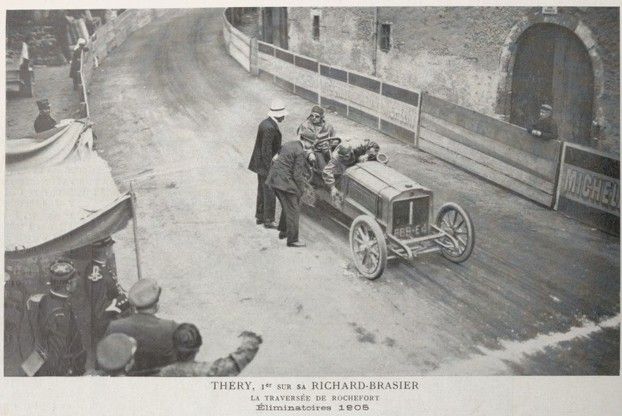
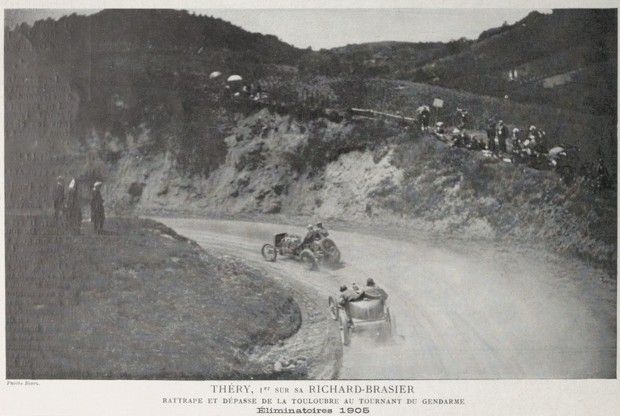
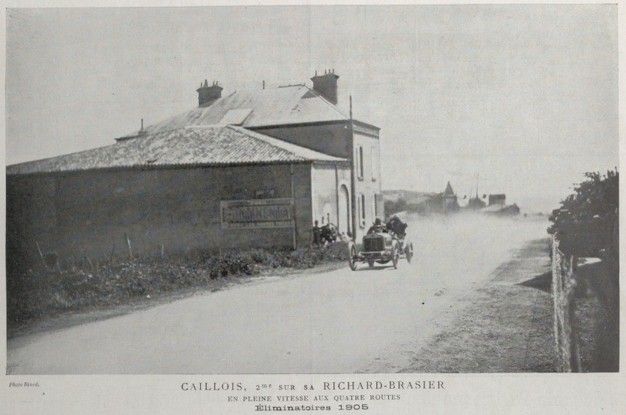
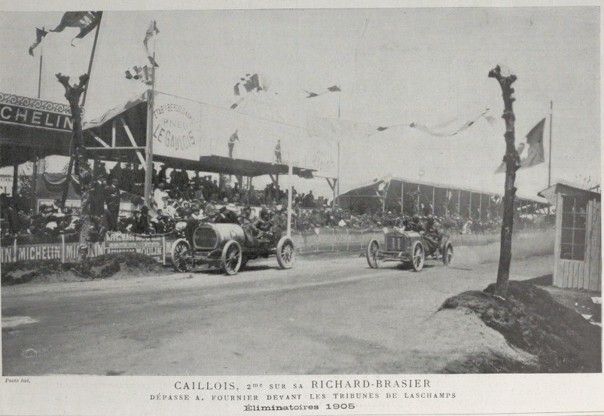
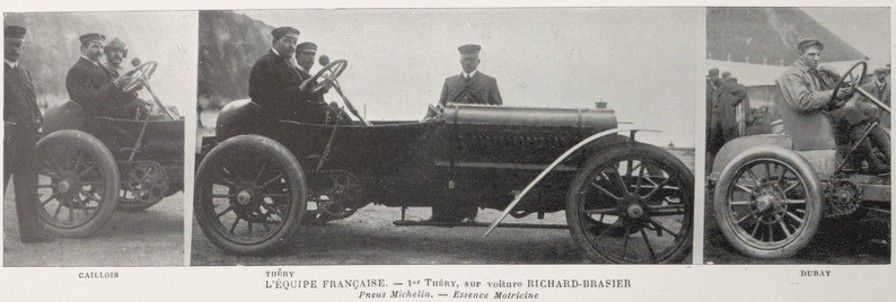
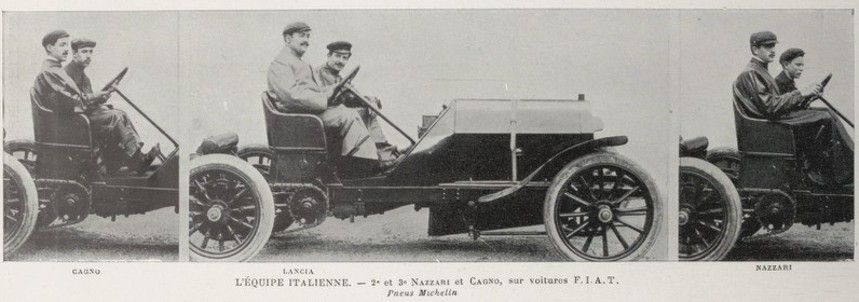
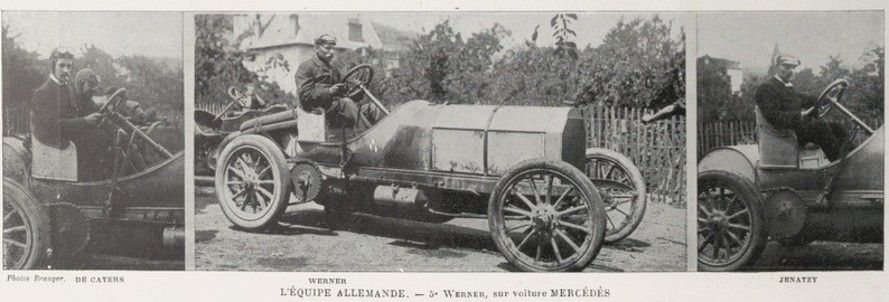
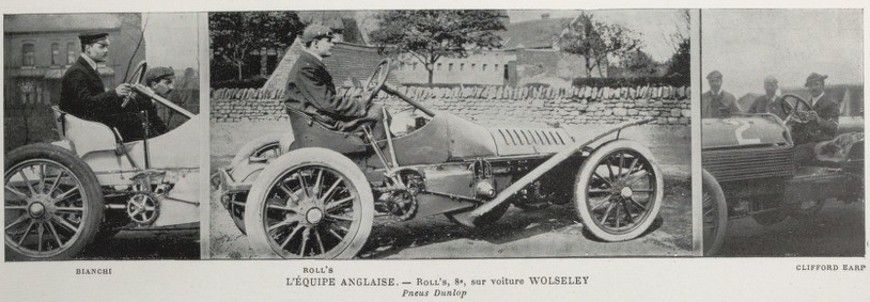


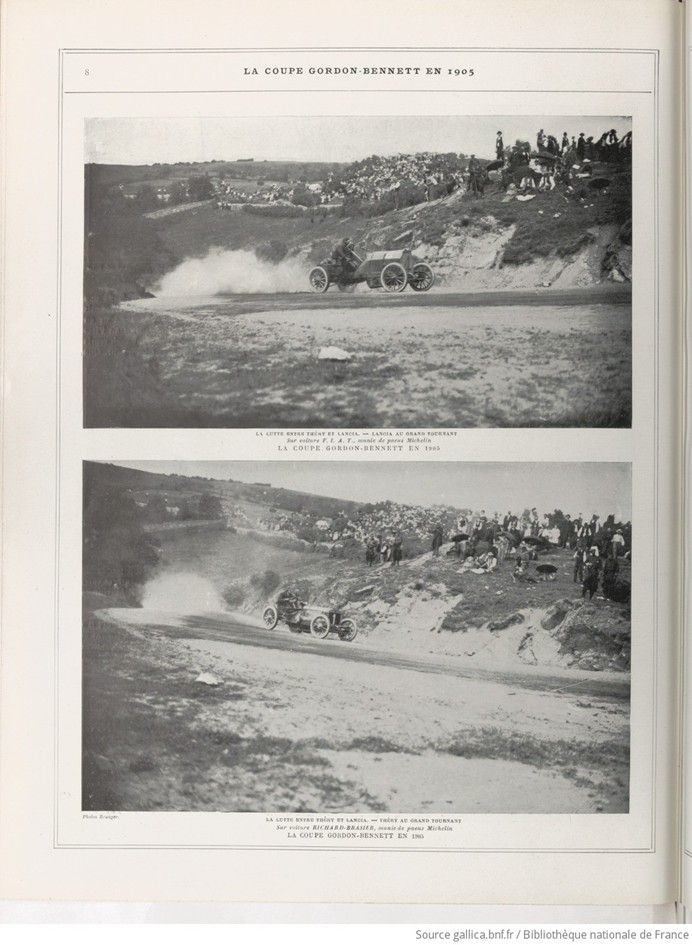
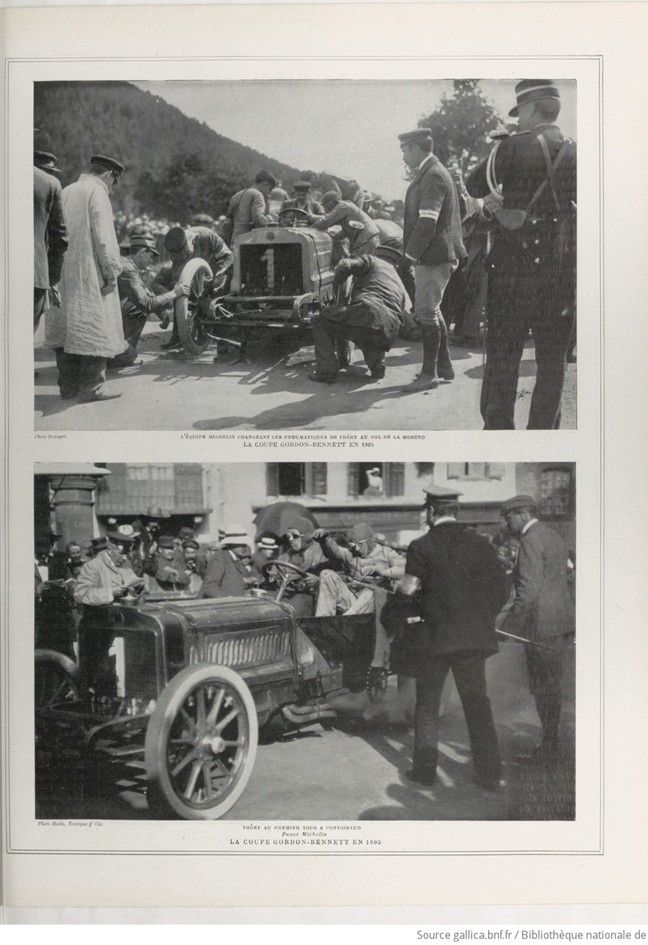
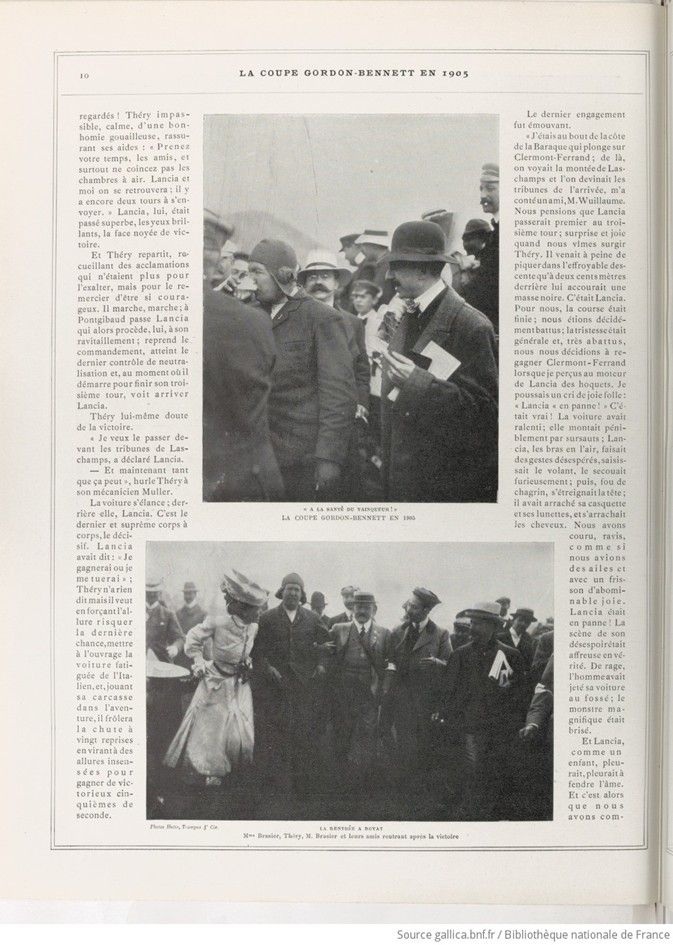
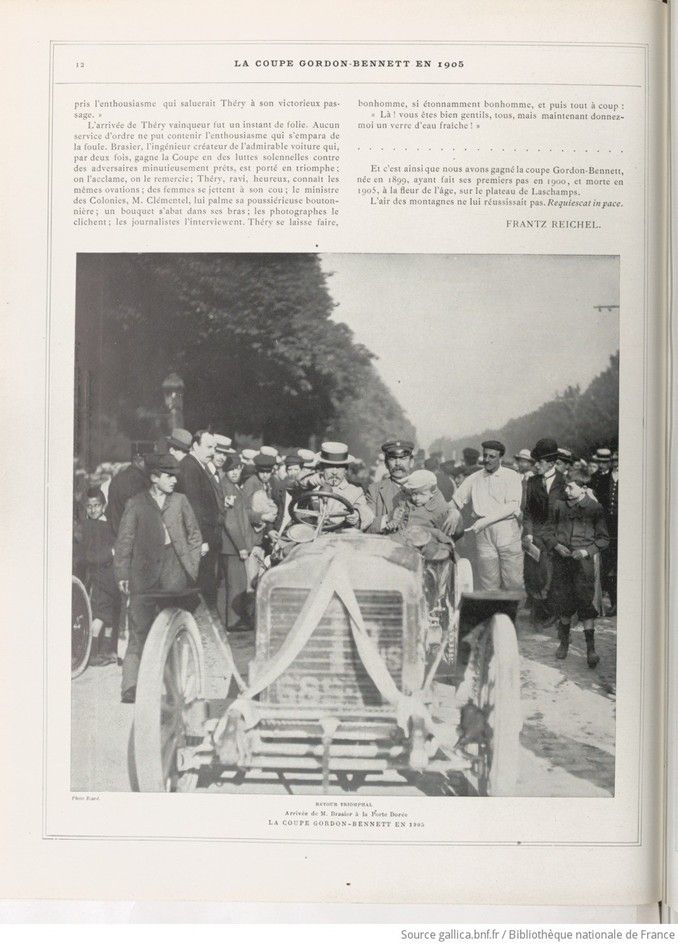
Théry s’est penché ; d’un geste, il a mis son magnifique engin en action ; la voiture a bondi. Théry est parti ! la Coupe est commencée, la lutte est engagée. De formidables encouragements sont jetés à notre champion qui file, file, grimpe la côte et disparaît bientôt accompagné de toutes nos espérances et de nos passionnés souhaits, dans le mystère boisé du col de la Moreno, Derrière lui, dans leur ordre et aux intervalles prévus, dix-sept de ses rivaux s’élancent à sa poursuite, dont deux portent encore les couleurs de la France, le brave Caillois et le vaillant Duray. Mais comme il était parti le premier, il nous semblait que Théry nous personnifiait à lui tout seul, et que [nous assistions ainsi à une empoignante chasse à courre automobile, l’Allemagne, l’Amérique, l’Angleterre, l’Autriche et l’Italie s’efforçant d’atteindre la France pour lui ravir un peu de son patrimoine et le fruit de ses efforts créateurs.
La lutte fut simple mais magnifique et, dès les premiers kilomètres, elle se réduisit au plus émouvant des duels entre deux hommes et deux voitures, le Français Théry et l’Italien Lancia, la voiture Richard-Brasier et la voiture italienne Fiat. Les deux nations-sœurs furent tout de suite seules en scène ; ce fut un admirable drame de famille parmi quelques comparses anglosaxons, dont le génie fut cette fois magistralement accablé par le génie latin.
Les mots ne peuvent donner une idée exacte de l’acharnement de la partie engagée entre Théry et Lancia. Dans une marche superbe, Théry, exact comme un chronomètre, venait de terminer, frénétiquement acclamé, son premier tour en 1 h. 41 m., lorsque, neuf minutes après lui, surgissait l’Italien Lancia qui, dans une marche foudroyante, lui avait repris six minutes de son retard. Déjà les étrangers triomphent. Que leur importe le vainqueur, pourvu qu’il ne soit pas Français !
Les deux rivaux ont à nouveau disparu, l’un poursuivant l’autre qui ne sait pas que la Victoire après laquelle il court est maintenant derrière lui, à ses trousses. Un coup de canon annonce le premier du second tour ! Sur le plateau de Laschamps, 30 ou 40.000 spectateurs ont les yeux fixés sur l’horizon. Toute la plaine est dans ‚angoisse ; quel est celui qui va surgir ? Une rumeur joyeuse et délirante vole, enthousiasme les monts et les bois. C’est Théry ! On crie :
« C’est lui ! c’est lui ! Vive la France ! »
Les gens s’embrassent, dansent… et tout à coup toutes les joies s’immobilisent : un autre coup de canon a retenti, et voici qu’apparaît, le serrant à deux minutes d’intervalle, la voiture noire de Lancia.
Théry serait donc battu !
Au col de la Moreno, Lancia est maintenant devant lui ; il a passé le Français tandis qu’il procédait à son ravitaillement et changeait ses quatre pneumatiques. Théry et Lancia s’étaient regardés ! Théry impassible, calme, d’une bonhomie gouailleuse, rassurant ses aides : « Prenez votre temps, les amis, et surtout ne coincez pas les chambres à air. Lancia et moi on se retrouvera ; il y a encore deux tours à s’envoyer. » Lancia, lui, était passé superbe, les yeux brillants, la face noyée de victoire.
Et Théry repartit, recueillant des acclamations qui n’étaient plus pour l’exalter, mais pour le remercier d’être si courageux. Il marche, marche ; à Pontgibaud passe Lancia qui alors procède, lui, à son ravitaillement ; reprend le commandement, atteint le dernier contrôle de neutralisation et, au moment où il démarre pour finir son troisième tour, voit arriver Lancia.
Théry lui-même doute de la victoire.
« Je veux le passer devant les tribunes de Laschamps, a déclaré Lancia.
— Et maintenant tant que ça peut », hurle Théry à son mécanicien Muller.
La voiture s’élance ; derrière elle, Lancia. C’est le dernier et suprême corps à corps, le décisif. Lancia avait dit : « Je gagnerai ou je me tuerai » ; Théry n’a rien dit mais il veut en forçant l’allure risquer la dernière chance, mettre à l’ouvrage la voiture fatiguée de l’Italien, et, jouant sa carcasse dans l’aventure, il frôlera la chute à vingt reprises en virant à des allures insensées pour gagner de victorieux cinquièmes de seconde.
Le dernier engagement fut émouvant.
« J’étais au bout de la côte de la Baraque qui plonge sur Clermont-Ferrand ; de là, on voyait la montée de Laschamps et l’on devinait les tribunes de l’arrivée, m’a conté un ami, M. Wuillaume. Nous pensions que Lancia passerait premier au troisième tour ; surprise et joie quand nous vîmes surgir Théry. Il venait à peine de piquer dans l’effroyable descente qu’à deux cents mètres derrière lui accourait une masse noire. C’était Lancia. Pour nous, la course était finie ; nous étions décidément battus ; la tristesse était générale et, très abattus, nous nous décidions à regagner Clermont-Ferrand lorsque je perçus au moteur de Lancia des hoquets. Je poussais un cri de joie folle : « Lancia « en panne ! » C’était vrai ! La voiture avait ralenti ; elle montait péniblement par sursauts ; Lancia, les bras en l’air, faisait des gestes désespérés, saisissait le volant, le secouait furieusement; puis, fou de chagrin, s’étreignait la tête; il avait arraché sa casquette et ses lunettes, et s’arrachait les cheveux. Nous avons couru, ravis, comme si nous avions des ailes et avec un frisson d’abominable joie.
Lancia était en panne ! La scène de son désespoir était affreuse en vérité. De rage, l’homme avait jeté sa voiture au fossé ; le monstre magnifique était brisé.
Et Lancia, comme un enfant, pleurait, pleurait à fendre l’âme. Et c’est alors que nous avons compris l’enthousiasme qui saluerait Théry à son victorieux passage. »
L’arrivée de Théry vainqueur fut un instant de folie. Aucun service d’ordre ne put contenir l’enthousiasme qui s’empara de la foule. Brasier, l’ingénieur créateur de l’admirable voiture qui, par deux fois, gagne la Coupe en des luttes solennelles contre des adversaires minutieusement prêts, est porté en triomphe; on l’acclame, on le remercie; Théry, ravi, heureux, connaît les mêmes ovations ; des femmes se jettent à son cou ; le ministre des Colonies, M. Clémentel, lui palme sa poussiérieuse boutonnière ; un bouquet s’abat dans ses bras ; les photographes le clichent ; les journalistes l’interviewent. Théry se laisse faire, bonhomme, si étonnamment bonhomme, et puis tout à coup : « Là ! vous êtes bien gentils, tous, mais maintenant donnez-moi un verre d’eau fraîche ! »
…………………..
Et c’est ainsi que nous avons gagné la coupe Gordon-Bennett, née en 1899, ayant fait ses premiers pas en 1900, et morte en 1905, à la fleur de l’âge, sur le plateau de Laschamps. L’air des montagnes ne lui réussissait pas. Requiescat in pace. FRANTZ REICHEL.
Textes sous les photos.
Page 4 – LA PASSERELLE ET LE CONTROLE DE PONTGIBAUD (Photo Tresca)
Page 6 – LA COUPE GORDON-BENNETT EN 1905
CAILLOIS – THÈRY – DURAY : L’ÉQUIPE FRANÇAISE. — 1er THÉRY, sur voiture RICHARD-BRASIER, Pneus Michelin. — Essence Motricine
CAGNO – LANCIA – NAZZARI : L’ÉQUIPE ITALIENNE. — 2e et 3e NAZZARI et CAGNO, sur voitures F.I.A.T., Pneus Michelin
DE CATERS – WERNER – JENATZY : L’ÉQUIPE ALLEMANDE. — 5e WERNER, sur voiture MERCÉDÈS
Page 7 – LA COUPE GORDON-BENNETT EN I905
BIANCHI – ROLL’S – CLIFFORD EARP : L’ÉQUIPE ANGLAISE. — ROLL’S, 8e, sur voiture WOLSELEY, Pneus Dunlop
BURTON – BRAUN – HIERONYMUS : L’ÉQUIPE AUTRICHIENNE. — BRAUN, 10e, sur voiture MERCÉDÈS AUTRICHIENNE
DINGLEY – LYTLE – TRACY : L’ÉQUIPE AMÉRICAINE. — LYTLE, 12e, sur voiture POPE TOLEDO (Photos Branger)
Page 8 – LA COUPE GORDON BENNETT EN 1905
LA LUTTE ENTRE THÈRY ET LANCIA. — LANCIA AU GRAND TOURNANT, Sur voiture F. I. A. T., munie de pneus Michelin
LA LUTTE ENTRE -THERY ET LANCIA. — THERY AU GRAND TOURNANT, Sur voiture RICHAR D-BRASIER, munie de pneus Michelin
LA COUPE GORDON-BENNETT EN 1905 (Photo Branger)
Page 9 – L’ÉQUIPE MICHELIN CHANGEANT LES PNEUMATIQUUS DE THÉRY AU COL DE LA MORENO – LA COUPE GORDON-BENNETT EN 1905
THÉRY AU PREMIER TOUR A PONTGIBAUD – Pneus Michelin – LA COUPE GORDON-BENNETT EN 1905
Page 10 – « A LA SANTÉ DU VAINQUEUR « – LA COUPE GORDON-BENNETT EN 1905
LA RENTRÉE A ROYAT – Mme Brasier, Théry, M. Brasier et leurs amis rentrant après la victoire (Photos Hutin, Trampus & Cie.)
Page 11 – LE PARC DES AUTOMOBILES A LASCHAMPS, LA COUPE GORDON-BENNETT EN 19005 (Photos Hutin, Trampus & Cie.)
Page 12 – RETOUR TRIOMPHAL – Arrivée de M. Brasier à la Porte Dorée – LA COUPE GORDON-BENNETT EN 1905 (Photo Biard.)
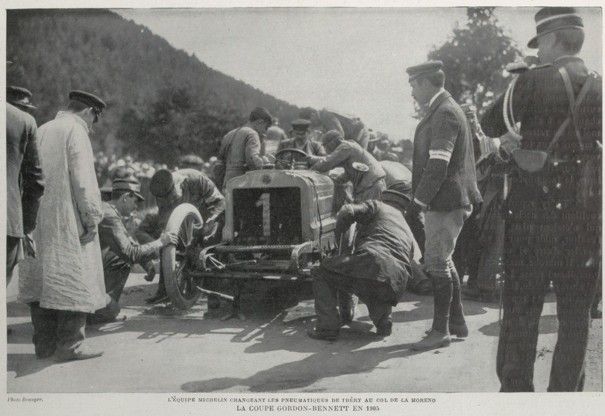
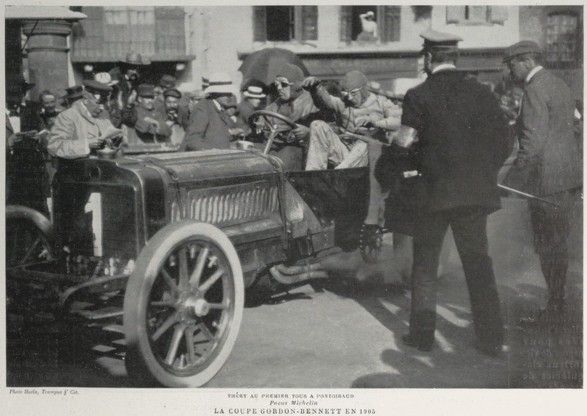
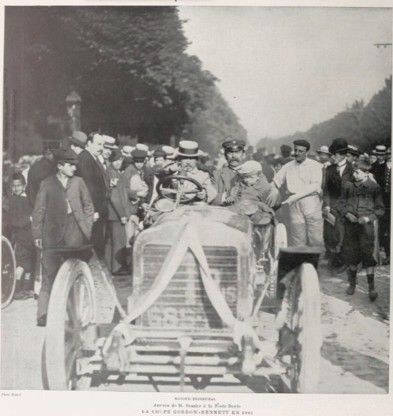
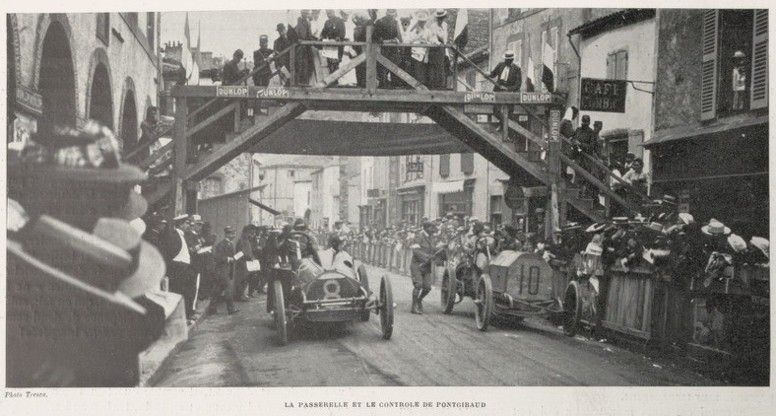
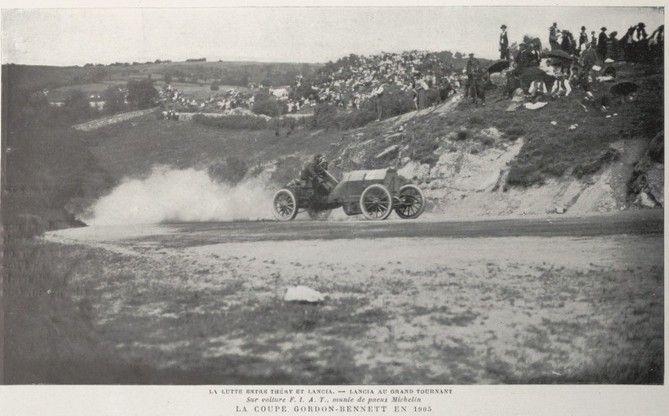
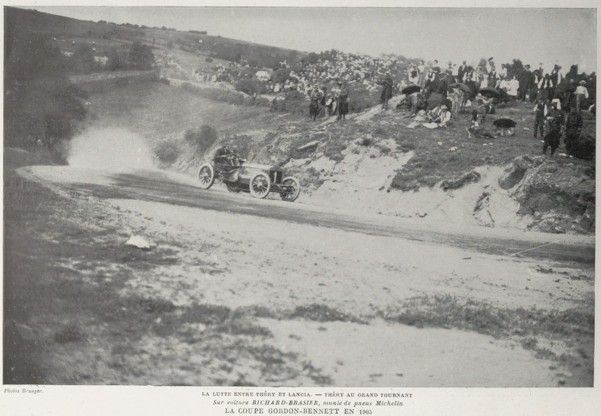
Translation by motorracinghistory.com, supported by DeepL.com
Les Sports Modernes, Vol. 8, 2nd Serie, No. 3, July 1905
THE GORDON-BENNETT CUP IN 1905
EVOHÉ! We have won it once again, the Cup, the famous, the glorious Cup; the dangerous Cup. On Wednesday, July 5, the French industry emerged victorious from the perilous game that it had meekly agreed to play for six years. Honor and interests are safe; our most subtle self-esteem is satisfied: the hurtful taunts that our rivals had already forged for us to overwhelm us in a defeat they thought certain, were useless. Before running it for the sixth time, we had declared that it would be the last, and as we triumphed in it, the foreigners had no consolation in taking us on ……. the eternal grudge they bear against us.
Since the Cup is defunct – they say in the least – it must be acknowledged that we gave it a glorious funeral. It died in a splendid apotheosis, whose grandiose and moving events took place in the most majestic of settings, through the mountains and lively passes of the Auvergne, and on the vast Laschamps plateau, at the foot of the lofty mass of the Puy de Dôme, facing the admirable Limagne, the classic, golden and heroic Gergovie, which was illustrated by the prowess of our Vercingétorix.
Immense crowds experienced, there, the anxiety and excitement of the incidents of a cup where we were, in an unprecedented duel of ardor and incidents, constantly beaten and victorious; ten thousand cars—at the very least, affirmed by statisticans — had lined up along the road, strange and curious, seeming to follow the struggle of their fascinating and dizzying counterparts, with their bonnets breathing the dust of the road and their headlights, huge eyes, watching them pass. Five or six hundred thousand people had gathered along the route, perhaps more, certainly not fewer, because, on the occasion of the sensational event, the whole country, which for two months had been overwhelmed by the race drivers terrorizing the roads with their daily trials, was celebrating this time: workshops, shops, factories, everything was closed, and from far, far away in the region, the poor and good people had come to “see Théry win”. As they knew that the road to the Cup would be closed to traffic early, they all set off in the night or at dawn to walk or chariot-bank (* is probably something like “chariot-banking”) to Laschamps, Rochefort, Laqueuille, Volvic, the descent of the Baraque or other dangerous bends, with the vague hope of onlookers of being where the terrible accident would occur that the ominous scribes had uselessly predicted.
And so it was on a dark, stormy night, illuminated by distant lightning or from time to time by the tragic apparitions of the moon showing itself through the rifts in the clouds, or in the parlor of the dawning day, that an extraordinary number of curious people came out, on foot, by car or by motorbike. The pedestrians carried lanterns and bundles of food at the end of a stick. They sang, laughed and called out to those who were lazily making their way to the high plateaus in various vehicles. In the distance, running through the mountains and woods, the horns of the cars could be heard constantly mooing as they paraded in fast, hurried torrents, in the luminous waves of blinding headlights.
The view of the Laschamps plateau, where the departures and arrivals took place, was admirably picturesque. Along the road, whose trees had been stripped of their foliage, stands of spectators were erected; tents were dotted about everywhere, some large and some small, some round and some square; others lay straight across the ground, destroyed by a hurricane that had devastated the plateau the day before. Here stood the gendarmerie barracks, which housed a squadron. Men slept randomly on bales of straw or rolled up in blankets. A thousand wood fires, around which groups struggling against the cold huddled, dotted the plain; people were on the march in a line towards various points. And this scene, in the shadow of the Puy de Dôme, whose giant mass stood out above the plateau, gave the observer the impression of a vast thing that stirred and heightened the emotion. — When the solemn and decisive hour of departure came, an emotional silence immediately fell. All these crowds, which up until that moment had been so noisy, fell silent of their own accord, and suddenly all that could be heard was the dry backfire of the engine of Théry’s Richard-Brasier, which, with its beautiful lines and French blue paint, was waiting for the timekeeper’s signal to dash off and race towards victory or defeat.
Théry leaned forward and with a gesture set his magnificent machine in motion; the car leapt into action. Théry was off! The Cup had begun, the fight was on. Our champion was given a tremendous cheer as he sped away, up the hill and soon disappeared, accompanied by all our hopes and passionate wishes, into the wooded mystery of the Moreno Pass. Behind him, in their order and at the expected intervals, seventeen of his rivals set off in pursuit, two of whom are still flying the colors of France, the brave Caillois and the valiant Duray. But as he had set off first, it seemed to us that Théry personified us all by himself, and that [we were thus witnessing a gripping car hunt, with Germany, America, England, Austria and Italy striving to overtake France in order to take away a little of its heritage and the fruit of its creative efforts.
The struggle was simple but magnificent and, from the very first kilometers, it boiled down to the most stirring of duels between two men and two cars, the French Théry and the Italian Lancia, the Richard-Brasier car and the Italian Fiat. The two sister nations were immediately alone on the scene; it was an admirable family drama among a few Anglo-Saxon accomplices, whose genius this time was masterfully overwhelmed by Latin genius.
Words cannot give an accurate idea of the fierceness of the match between Théry and Lancia. In a superb drive, Théry, precise as a stopwatch, had just finished his first lap in 1 hr. 41 mins., when, nine minutes behind him, the Italian Lancia appeared, who, in a lightning pace, had made up six minutes of his deficit. The foreigners are already triumphing. Who cares who the winner is, as long as he’s not French!
The two rivals have disappeared again, one chasing the other, who does not know that the Victory he is running after is now behind him, on his tail. A cannon shot announces the start of the second lap! On the Laschamps plateau, 30 or 40,000 spectators have their eyes fixed on the horizon. The whole plane is in anguish; which one will emerge? A joyful and delirious rumor flies, filling the hills and the woods with enthusiasm. It’s Théry! People shout:
“It’s him! It’s him! Long live France!”
People kiss each other, dance… and suddenly all the joy comes to a standstill: another cannon shot has sounded, and here comes the black Lancia, two minutes apart.
Théry would therefore be beaten!
At the Col de la Moreno, Lancia was now ahead of him; he had passed the Frenchman while he was refueling and changing all four of his tires. Théry and Lancia had looked at each other! Théry, impassive, calm, with a good-natured banter, reassuring his assistants: “Take your time, friends, and above all don’t get the inner chambers stuck. Lancia and I will meet again; there are still two laps to go.” Lancia, meanwhile, had passed by superbly, his eyes shining, his face awash with victory.
And Théry set off again, receiving cheers that were no longer to exalt him, but to thank him for being so brave. He walked and walked; at Pontgibaud, Lancia passed him and then proceeded to refuel; he took the lead again, reached the last neutralization control and, just as he set off to finish his third lap, saw Lancia arrive.
Théry himself doubted he would win.
“I want to pass him in front of the Laschamps stands,” said Lancia.
– And now as long as it takes,” Théry shouted to his mechanic Muller.
The car takes off; behind it, Lancia. It was the last and supreme body-to-body combat, the decisive one. Lancia had said, “I will win or I will kill myself”; Théry said nothing, but by forcing the pace he wanted to risk one last chance, to put the Italian’s tired car to work, and, risking his carcass in the adventure, he narrowly avoided crashing twenty times, turning at insane speeds to gain those victorious fifths of a second.
The final engagement was moving.
“I was at the end of the Côte de la Baraque, which plunges down to Clermont-Ferrand; from there, you could see the climb up to Laschamps and guess where the finish stands would be,” a friend of mine, Mr. Wuillaume, told me. ”We thought that Lancia would be first on the third lap; surprise and joy when we saw Théry appear. He had barely taken the plunge down the terrifying descent when, two hundred meters behind him, a black mass appeared. It was Lancia. For us, the race was over; we were definitely beaten; there was general sadness and, very dejected, we decided to return to Clermont-Ferrand when I heard the Lancia engine spluttering. I let out a cry of wild joy: “Lancia broken down!” It was true! The car had slowed down; it was laboriously climbing in fits and starts; Lancia, arms in the air, was making desperate gestures, grabbing the steering wheel, shaking it furiously; then, mad with grief, he was hugging his head; he had torn off his cap and glasses, and was pulling out his hair. We ran, delighted, as if we had wings and with a shiver of abominable joy.
Lancia had broken down! The scene of his despair was truly awful. In a rage, the man had thrown his car into the ditch; the magnificent monster was broken.
And Lancia, like a child, cried and cried, his tears piercing the soul. And that is when we understood the enthusiasm that would greet Théry as he victoriously passed by.”
Théry’s arrival as the winner was a moment of madness. No security service could contain the enthusiasm that took hold of the crowd. Brasier, the engineer who designed the remarkable car that twice won the Cup in formal contests against meticulously prepared opponents, was carried in triumph; he was cheered and thanked; Théry, delighted and happy, received the same ovations; women threw their arms around his neck; the Minister of the Colonies, Mr. Clémentel, presents him with his dusty buttonhole; a bouquet is thrown into his arms; the photographers take his picture; the journalists interview him. Théry lets them do as they please, good-naturedly, so surprisingly good-naturedly, and then suddenly: “There! You’re all very kind, but now give me a glass of cold water!”
…………………..
And that’s how we won the Gordon Bennett Cup, which was born in 1899, took its first steps in 1900, and died in 1905, in the prime of life, on the Laschamps plateau. The mountain air didn’t agree with him. Requiescat in pace. FRANTZ REICHEL.
Foto captions.
Page 4 – THE GATEWAY AND THE PONTGIBAUD CHECKPOINT (Photo Tresca)
Page 6 – THE GORDON-BENNETT CUP IN 1905
CAILLOIS – THÈRY – DURAY: THE FRENCH TEAM. — 1st THÉRY, in a RICHARD-BRASIER car, Michelin tires. — Motricine gasoline
CAGNO – LANCIA – NAZZARI: THE ITALIAN TEAM. — 2nd and 3rd NAZZARI and CAGNO, in F.I.A.T. cars, Michelin tires.
DE CATERS – WERNER – JENATZY: THE GERMAN TEAM. — 5th WERNER, in a MERCÉDÈS car.
Page 7 – THE GORDON-BENNETT CUP IN 1905
BIANCHI – ROLL’S – CLIFFORD EARP: THE ENGLISH TEAM. — ROLL’S, 8th, in a WOLSELEY car, Dunlop tires
BURTON – BRAUN – HIERONYMUS: THE AUSTRIAN TEAM. — BRAUN, 10th, on MERCEDES AUSTRIAN
DINGLEY – LYTLE – TRACY: THE AMERICAN TEAM. — LYTLE, 12th, on POPE TOLEDO (Photos Branger)
Page 8 – THE GORDON BENNETT CUP IN 1905
THE FIGHT BETWEEN THÈRY AND LANCIA. — LANCIA AT THE LARGE TURN, On a F. I. A. T. car, fitted with Michelin tires
THE FIGHT BETWEEN -THERY AND LANCIA. — THERY AT THE LARGE TURN, On a RICHARD D-BRASIER car, fitted with Michelin tires
THE GORDON-BENNETT CUP IN 1905 (Photo Branger)
Page 9 – THE MICHELIN TEAM CHANGING THE TYRES OF THÉRY AT THE COL DE LA MORENO – THE GORDON-BENNETT CUP IN 1905
THÉRY AT THE FIRST ROUND AT PONTGIBAUD – Michelin tires – THE GORDON-BENNETT CUP IN 1905
Page 10 – “TO THE WINNERS HEALTH” – THE GORDON-BENNETT CUP IN 1905
THE RETURN TO ROYAT – Mrs. Brasier, Théry, Mr. Brasier and their friends returning after the victory (Photos Hutin, Trampus & Cie.)
Page 11 THE CAR PARK AT LASCHAMPS, THE GORDON-BENNETT CUP IN 1905 (Photos Hutin, Trampus & Cie.)
Page 12 – TRIUMPHANT RETURN – Mr. Brasier’s arrival at the Porte Dorée – THE GORDON-BENNETT CUP IN 1905 (Photo Biard.)
